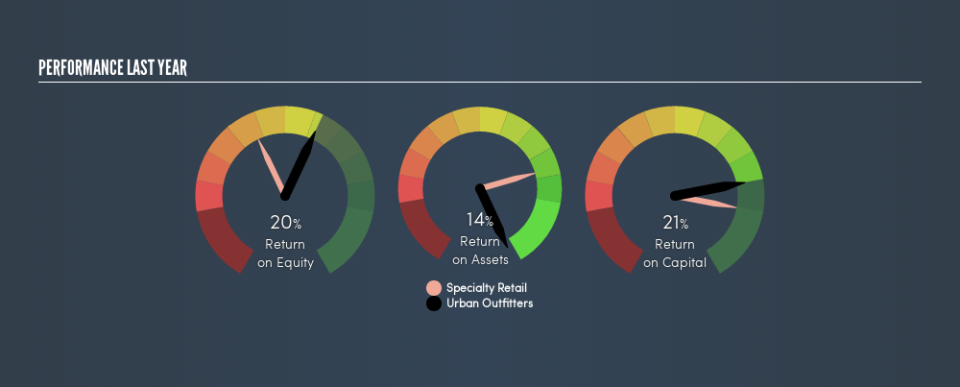Should You Like Urban Outfitters, Inc.’s (NASDAQ:URBN) High Return On Capital Employed?

Today we’ll evaluate Urban Outfitters, Inc. (NASDAQ:URBN) to determine whether it could have potential as an investment idea. Specifically, we’re going to calculate its Return On Capital Employed (ROCE), in the hopes of getting some insight into the business.
First, we’ll go over how we calculate ROCE. Second, we’ll look at its ROCE compared to similar companies. Then we’ll determine how its current liabilities are affecting its ROCE.
Understanding Return On Capital Employed (ROCE)
ROCE is a metric for evaluating how much pre-tax income (in percentage terms) a company earns on the capital invested in its business. All else being equal, a better business will have a higher ROCE. In brief, it is a useful tool, but it is not without drawbacks. Renowned investment researcher Michael Mauboussin has suggested that a high ROCE can indicate that ‘one dollar invested in the company generates value of more than one dollar’.
How Do You Calculate Return On Capital Employed?
Analysts use this formula to calculate return on capital employed:
Return on Capital Employed = Earnings Before Interest and Tax (EBIT) ÷ (Total Assets – Current Liabilities)
Or for Urban Outfitters:
0.21 = US$381m ÷ (US$2.2b – US$387m) (Based on the trailing twelve months to January 2019.)
So, Urban Outfitters has an ROCE of 21%.
Check out our latest analysis for Urban Outfitters
Does Urban Outfitters Have A Good ROCE?
One way to assess ROCE is to compare similar companies. Using our data, we find that Urban Outfitters’s ROCE is meaningfully better than the 13% average in the Specialty Retail industry. I think that’s good to see, since it implies the company is better than other companies at making the most of its capital. Setting aside the comparison to its industry for a moment, Urban Outfitters’s ROCE in absolute terms currently looks quite high.
It is important to remember that ROCE shows past performance, and is not necessarily predictive. Companies in cyclical industries can be difficult to understand using ROCE, as returns typically look high during boom times, and low during busts. ROCE is, after all, simply a snap shot of a single year. Since the future is so important for investors, you should check out our free report on analyst forecasts for Urban Outfitters.
How Urban Outfitters’s Current Liabilities Impact Its ROCE
Short term (or current) liabilities, are things like supplier invoices, overdrafts, or tax bills that need to be paid within 12 months. Due to the way the ROCE equation works, having large bills due in the near term can make it look as though a company has less capital employed, and thus a higher ROCE than usual. To check the impact of this, we calculate if a company has high current liabilities relative to its total assets.
Urban Outfitters has total assets of US$2.2b and current liabilities of US$387m. As a result, its current liabilities are equal to approximately 18% of its total assets. The fairly low level of current liabilities won’t have much impact on the already great ROCE.
The Bottom Line On Urban Outfitters’s ROCE
With low current liabilities and a high ROCE, Urban Outfitters could be worthy of further investigation. Of course, you might find a fantastic investment by looking at a few good candidates. So take a peek at this free list of companies with modest (or no) debt, trading on a P/E below 20.
For those who like to find winning investments this free list of growing companies with recent insider purchasing, could be just the ticket.
We aim to bring you long-term focused research analysis driven by fundamental data. Note that our analysis may not factor in the latest price-sensitive company announcements or qualitative material.
If you spot an error that warrants correction, please contact the editor at editorial-team@simplywallst.com. This article by Simply Wall St is general in nature. It does not constitute a recommendation to buy or sell any stock, and does not take account of your objectives, or your financial situation. Simply Wall St has no position in the stocks mentioned. Thank you for reading.

